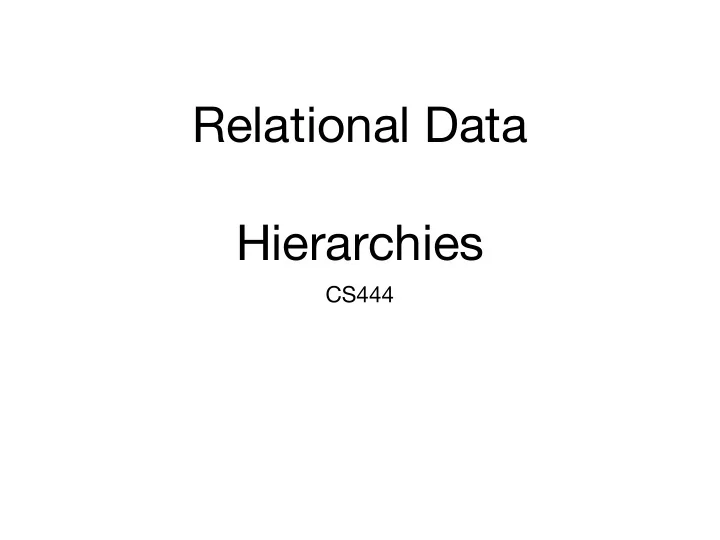

Relational Data Hierarchies CS444
Why hierarchies? http://www.sci.utah.edu/~miriah/cs6630/lectures/L13-trees-graphs.pdf
Scatterplots; dot plots; line charts, etc. Until now, our data points were “independent of one another”
In “relational data”, it’s the relationship between points that matters
• The reports-to relationship in an organization
• The “tree of life” • evolution of species creates branching mechanism and “ancestor-of” relationship
Tree Hierarchy • Tree relation • if a is child of b and a is child of c, then: • b is child of c or c is child of b, but not both at the same time • “Immediate boss is unique”
What do we want our drawings to show? • Who reports to whom • … and who doesn’t • How big are “sub-organizations” • …?
Many di ff erent ways to visualize trees
http://homes.cs.washington.edu/~jheer/files/zoo/ex/hierarchies/tree.html
http://jsfiddle.net/VividD/WDCpq/8/
http://www.cs.rug.nl/svcg/SoftVis/ViewFusion
http://treevis.net
Reingold-Tilford tree drawing • All of the before, plus: • Don’t waste horizontal space • If tree is symmetric, so should be the drawing http://hci.stanford.edu/courses/cs448b/f11/lectures/ CS448B-20111110-GraphsAndTrees.pdf
Reingold-Tilford Algorithm • Bottom-up tree traversal • y-coord is the depth of the node, x-coords are “locally defined” (so first is arbitrary) • merge trees • push right tree as close as possible to left tree (this is where the contour comes in) • position shifts saved at each node • parent nodes are centered above direct children • Final top-down pass to convert shifts to positions
Bubble Charts • Represent hierarchy by containment • Let’s work out a simple algo!
Treemaps • Represent hierarchy by containment , • … and sizes by areas • Let’s work out a simple algo!
Squarified Treemaps • A little harder, tries to make square shapes
Not all Hierarchies are Trees
The evolution of UNIX http://www.graphviz.org/Gallery/directed/unix.svg
The evolution of UNIX http://www.graphviz.org/Gallery/directed/unix.svg
Directed, Acyclic Graphs • Like a hierarchy, but “direct ancestor” is not unique
Given what we know about tree drawing, how do we draw a DAG?
Let’s draw a DAG • Compute rank : height of node • Requirement: if aRb, height(a) > height(b) • Order nodes of same rank to minimize crossings • Route edges • Gansner et al., A Technique for Drawing Directed Graphs. http://ieeexplore.ieee.org/stamp/stamp.jsp?tp=&arnumber=221135
Let’s draw a DAG • Gansner et al., A Technique for Drawing Directed Graphs. http://ieeexplore.ieee.org/stamp/stamp.jsp?tp=&arnumber=221135
Given what we know about treemaps, can we draw a DAG?
Euler Diagrams (Venn Diagrams)
Euler Diagrams • Represent relationship by containment • Algorithms are very complicated, tend to produce bad shapes
Euler Diagrams • Doesn’t scale to large diagrams http://raweb.inria.fr/rapportsactivite/RA2009/gravite/3.png
Euler Diagrams • Doesn’t scale to “large” diagrams 64 regions 16 regions
Recap Not a Hierarchy Hierarchy Sugiyama’s algorithm Not a Tree NEXT CLASS Euler Diagrams Reingold-Tilford A Tree NEXT CLASS Treemaps
Recommend
More recommend